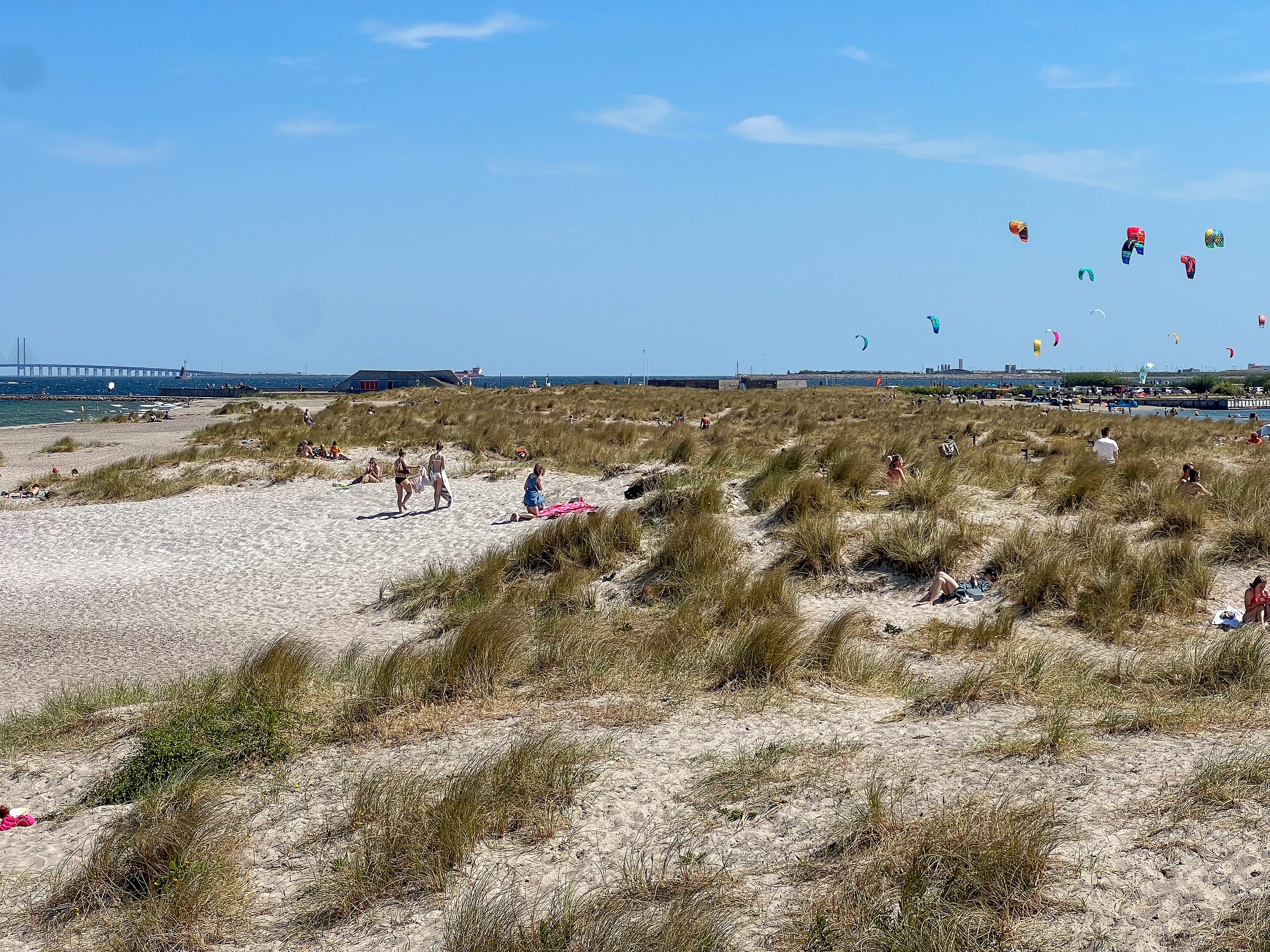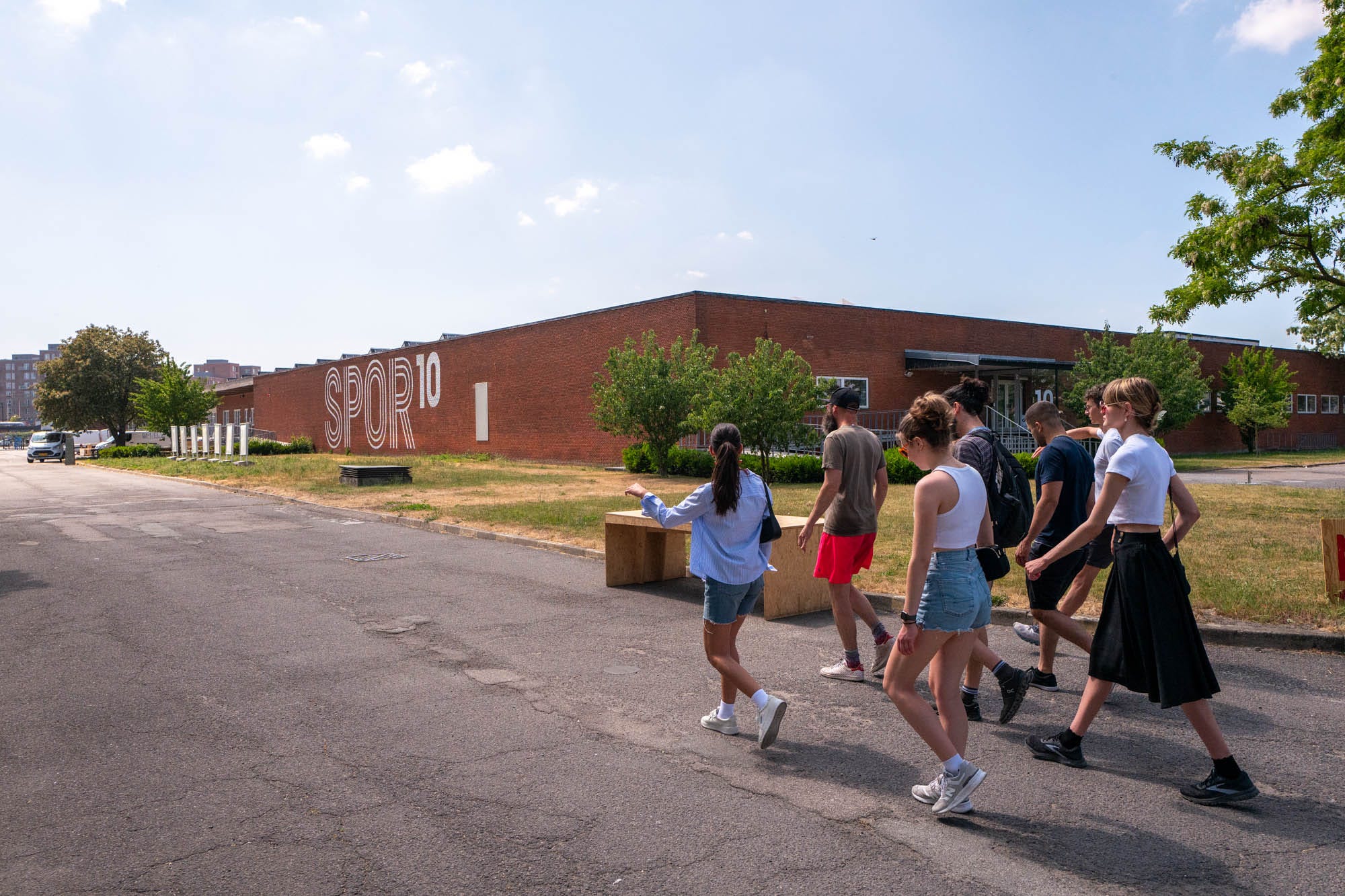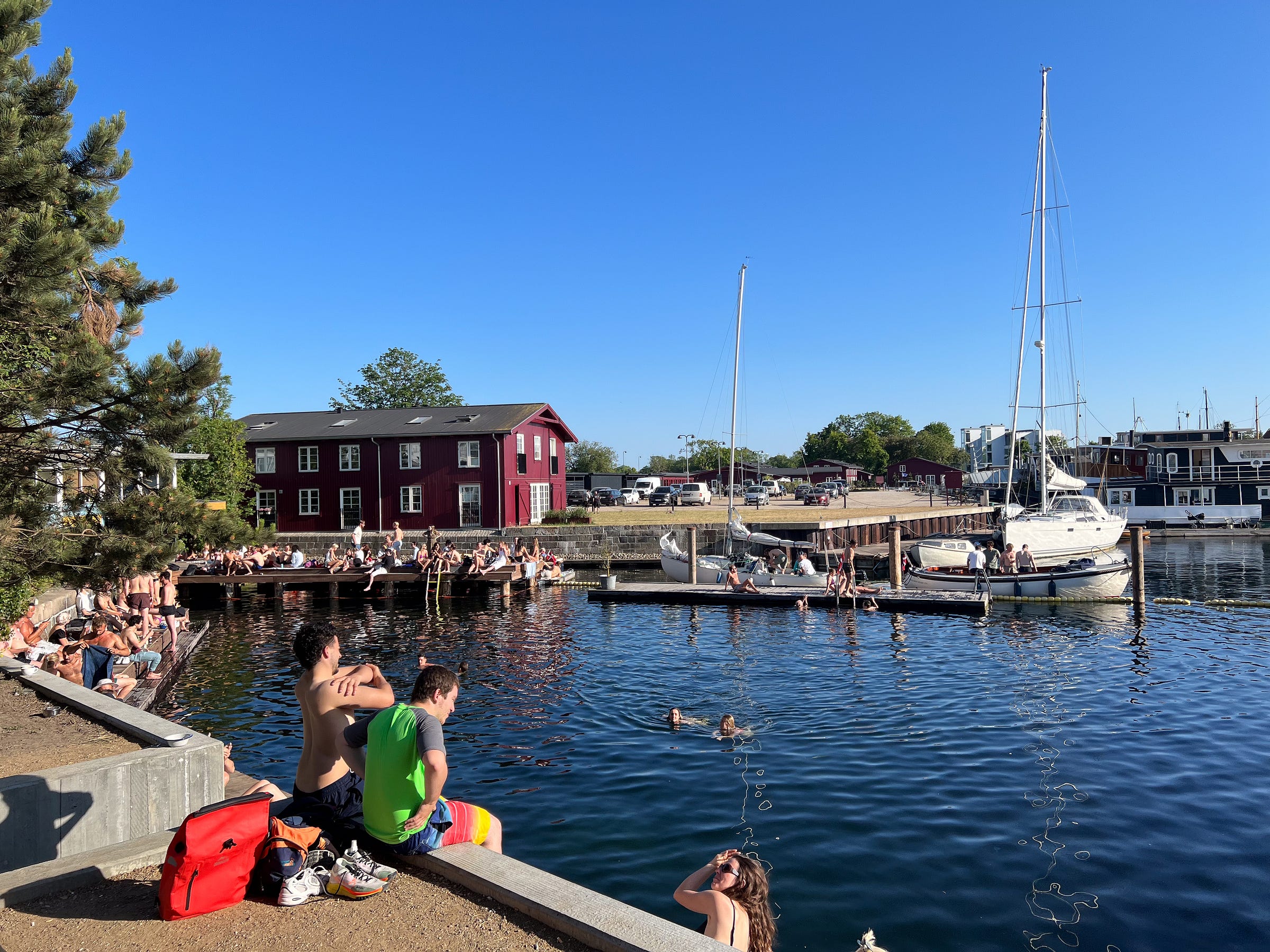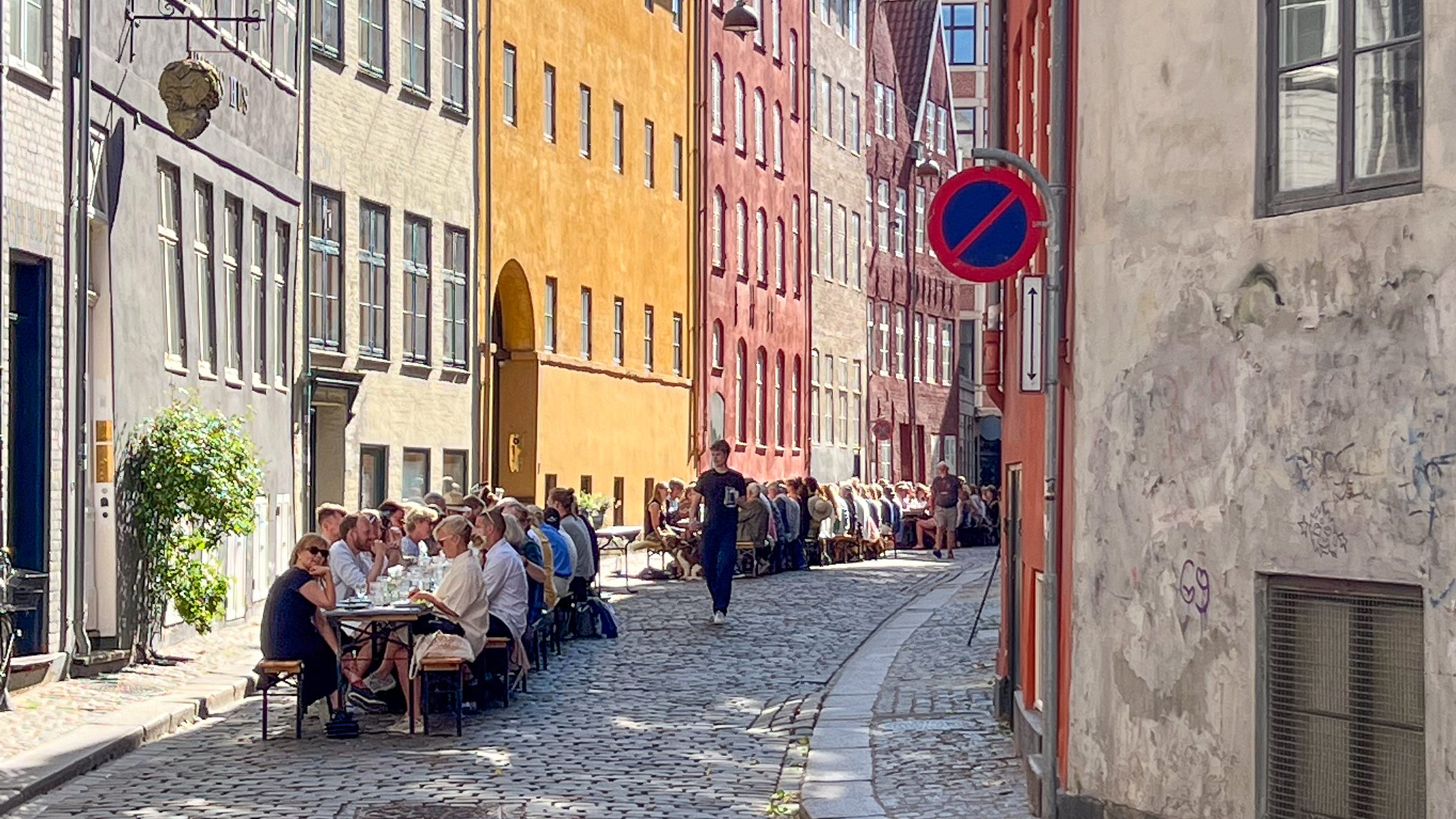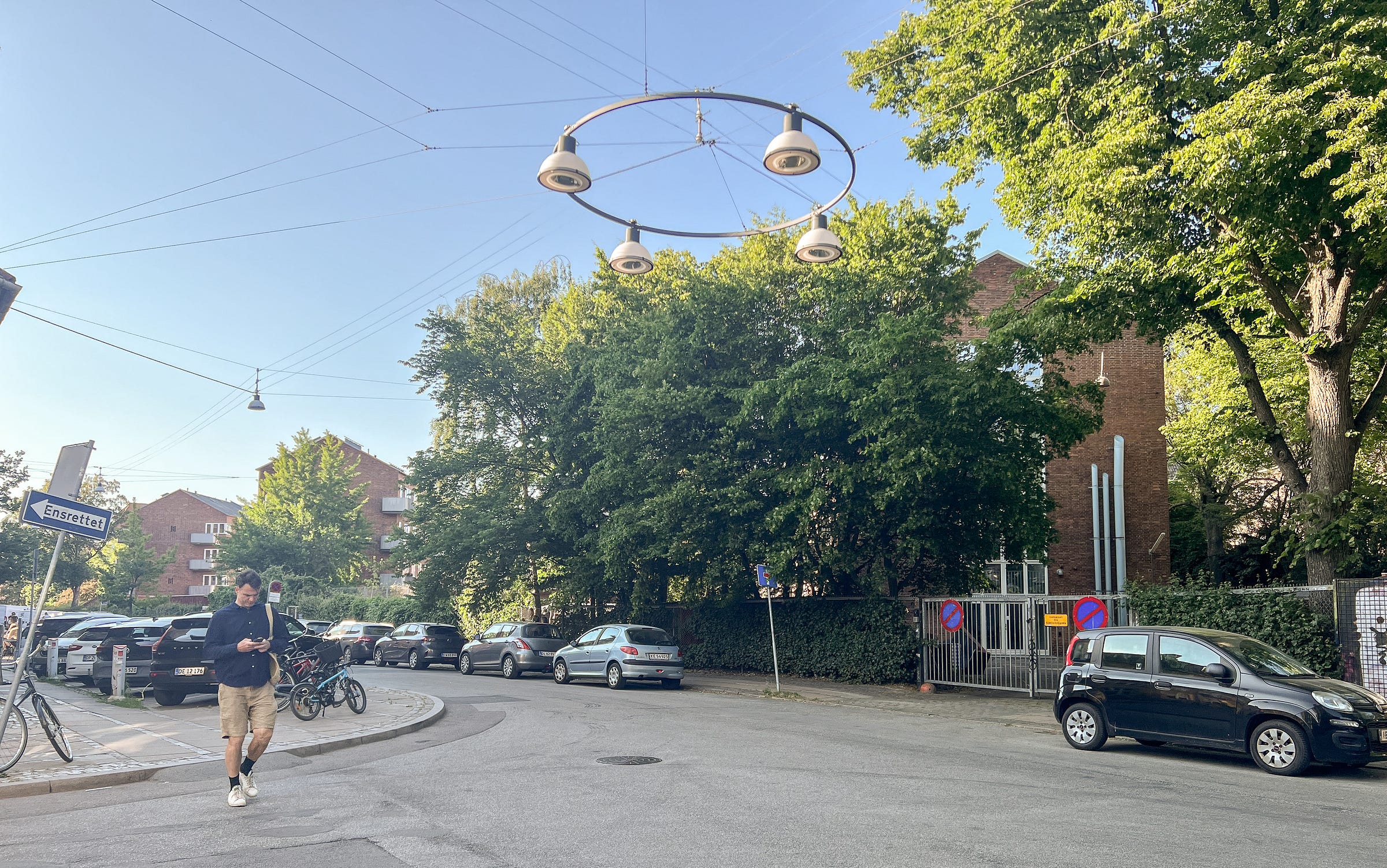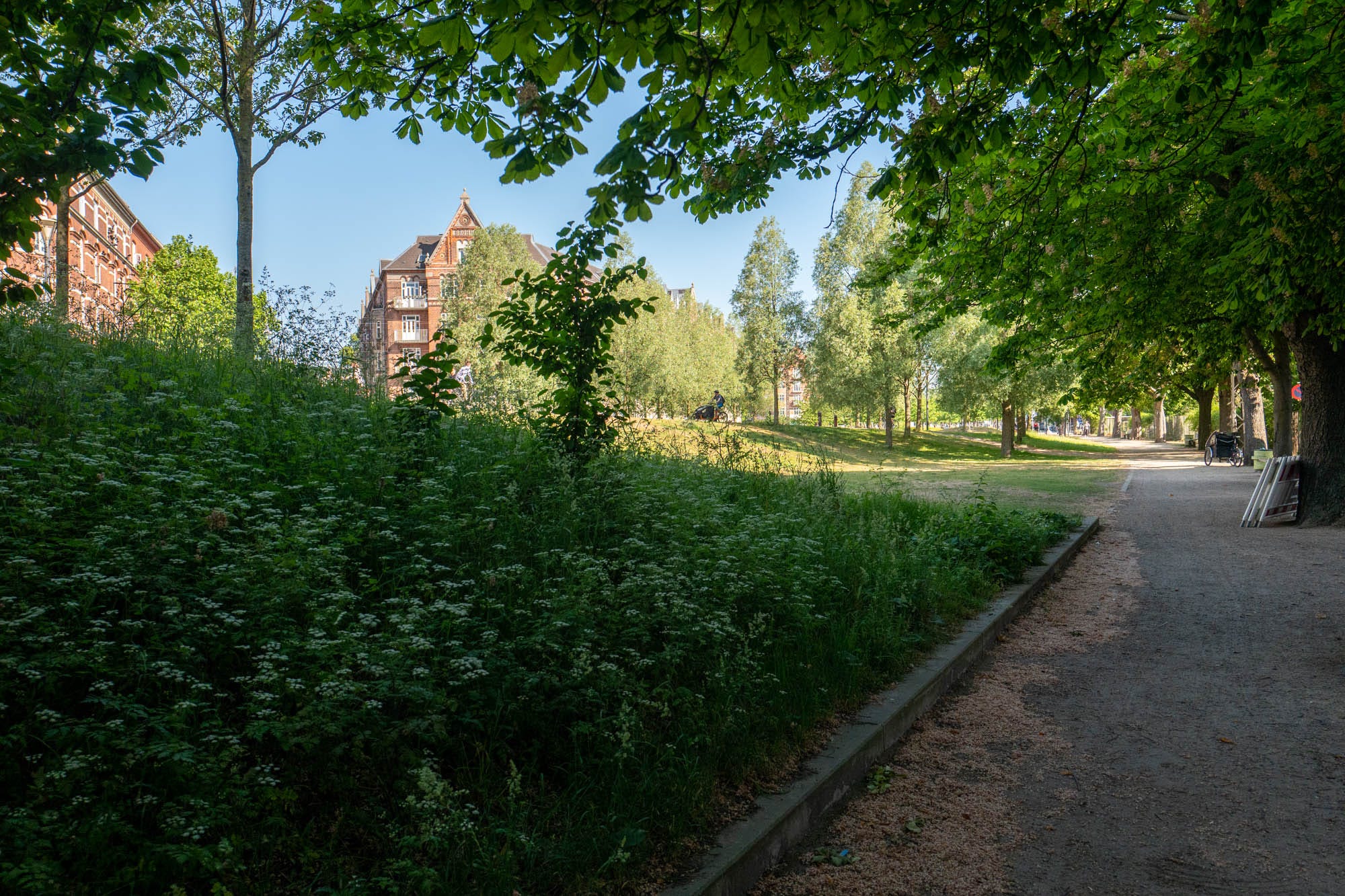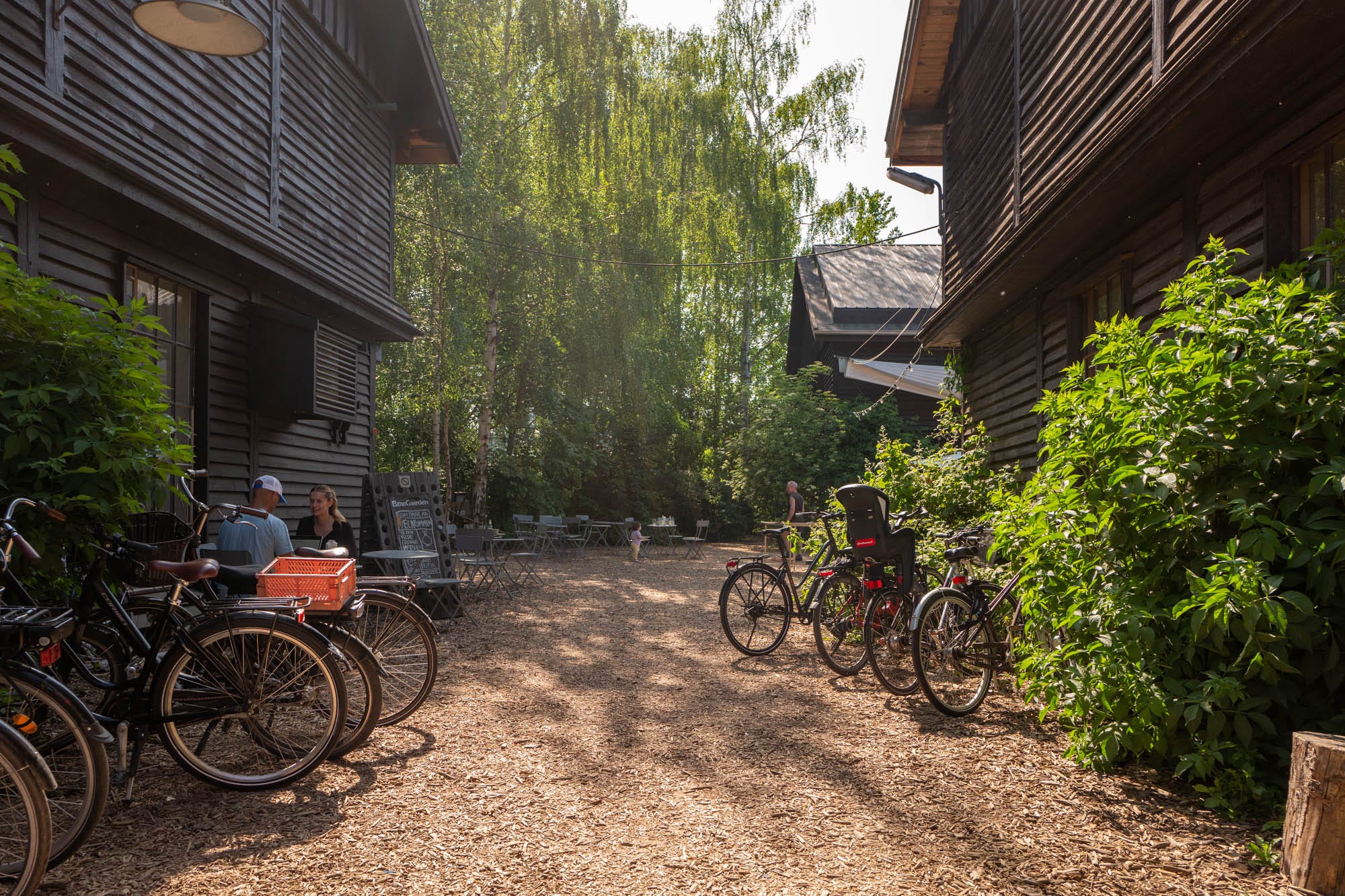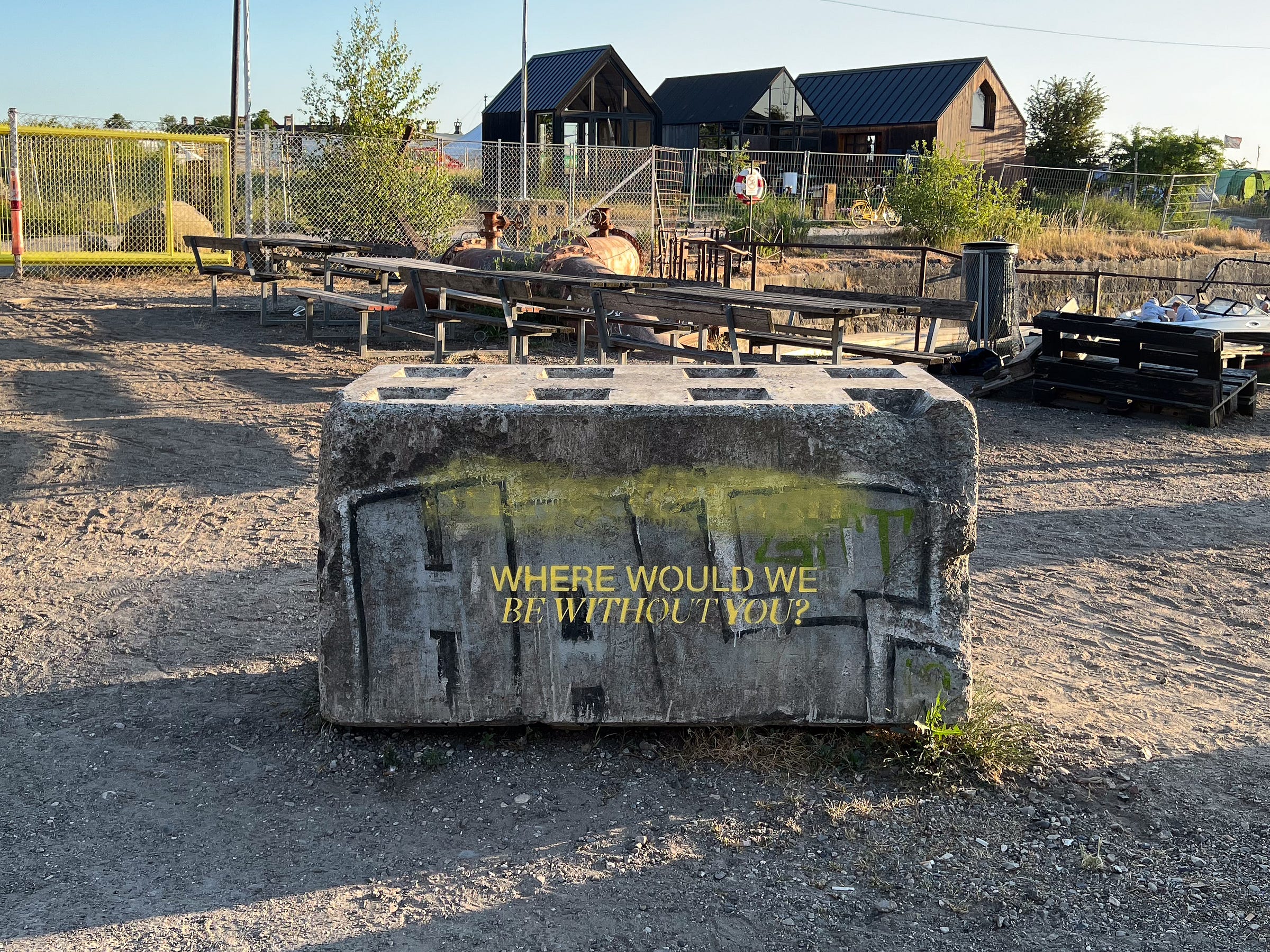Urban Technology at University of Michigan week 150
Risk, Learning, and the Sovereignty of Urban Technologies in Copenhagen
Hello from Copenhagen, where I've been traveling with Matthew Claudel, a visiting professor with whom I am co-teaching, and a group of Taubman College students from Architecture and Urban Planning who signed up for a supplementary travel course to learn about urban technology.
One of the rewards of teaching students about urban anything is watching them experience simple things for the first time, and in this particular city that includes delights like jumping into the sea on a hot summer afternoon—just because it's hot, and they wanted to, and they didn't need anyone's permission.
For Americans traveling in Denmark, and the nordic region in general, it is remarkable to witness quality of life so imminently accessible. Behold the public realm that's extremely refined and well designed! A street network where almost nothing is more than a 30-minute walk or 15 minutes by bike! A permissionless city… until it’s not. Travelogue and geopolitical technology musings below.
💬 Hello! This is the newsletter of the Urban Technology program at University of Michigan, in which we explore the ways that data, connectivity, computation, and automation can be harnessed to nurture and improve human life in cities. If you’re new here, try this short video of current students describing urban technology in their own words.
🇩🇰 Working the Pedals of Urban Technology
In 2005 a 2km-long artificial island was built off the cost of Amager beach just south of Central Copenhagen. Today it's rife with sunbathers, swimmers, kite surfers, skaters, and "a whole mini Venice Beach" in the words of Jeff Risom, an American transplant who is Chief Innovation Officer at Gehl, the renowned urban design firm, and our tour guide on a bright Saturday afternoon.
"They notice how much American kids get yelled at," is how Jeff responds when I ask how his Danish/American kids feel while traveling to the States: "Billy, don't climb on that!," he mimics nasally. And he's right: Denmark is a place of few guardrails, both figuratively and literally. The urban form and social constructs of Copenhagen reveal how many doors are closed in American cities: no swimming in (most) water. No waterfronts without railings. No internal courtyards used as shortcuts through the city, and few courtyards to speak of in the first place. No using the bathroom at a shop without buying something. No cycling without risking your life. No idea where a CCTV camera is watching you. All of these "no" statements are a "yes" in Copenhagen.
The students, many of whom were in Europe for the first time, were immediately envious of the urban freedoms available to them here, and I can understand why. But they were also surprised to learn that this quality of life slathered on thick across this city is not somehow innate to the soil of Denmark. In the 1980s Copenhagen was near bankruptcy, and the now-pedestrianized and cycle-friendly areas of downtown were mostly parking lots and roads.
Copenhagen stuns with its qualitative joys and these are built on the bedrock of resolve. Today's Copenhagen is the result of sustained investment, resulting in slow but steady transformation through actions such as removing 1% of parking per year. Pair that with constant measurement of outcomes, as explained by Sophia Schuff also of Gehl, then keep doing it for 20+ years and things really change.
Reflecting on recent developments in Detroit, this trip underlines the importance of designing the network as much as the nodes. Here's another aspect to it that's hard to wrap my mind around: the average Copenhagener bikes 9.2km per day yet cars have increased by 25% in the last 10 years, as we learned from Kika Kjærside at the Danish Architecture Center while touring an exhibition about Copenhagen’s generational transformation. It's a bracing example of the both/and reality of cities. In other words, Detroit can stop fighting about bikes vs. cars vs. transit, and just add transit and cycling infrastructure so that everyone has a choice.
In the next couple years a handful of major new institutions will open in Detroit, such as the Michigan Central renovation of the old train station and the U-M Center for Innovation, which will be housed in a new building downtown. These can be good on their own, but to be great they need to be connected in thoughtful ways, such as with streets that are dramatically safer for people using non-motorized transit, by adding infill density to the baggy blocks of Detroit, and by celebrating the diversity of race, background, and perspective that is America's strongest resource (and decidedly more scarce in Copenhagen).
As we visited the fine folks at Gehl, Space 10 (Thanks, Esteban + Allison!), Bloxhub (Thanks, Martine!), Danish Design Center (Thanks, Christian!), NREP, the Royal Danish Academy of Architecture (Thanks, Morten!), and Danish Technical University, we heard again and again about the progress Denmark is making on reducing its carbon footprint and maintaining the economic might of this little country that's smaller in land mass and population than the state of Michigan. If you follow trends in urbanism, the ‘wows’ of Denmark are old news; what was refreshing was how little we heard about technology.
It's there if you dig, but technology is rarely the headline in Copenhagen. Ask about how the public realm is designed and improved and you will learn from Gehl about the app they developed to track public life activity and sentiment. Observe the infrastructure and you will see the Inderhavnsbroen bridge that retracts like a giant mechanical gangplank. Visit NREP's ongoing work in Jernbanebyen and you will see maker spaces and hear about mobility hubs in the making. Urban technology is thriving in Denmark, but as a subtext. That feels right, because city life should be the cause for technology, not the end. Perhaps it's also a post-rationalization of the fact that the tech hubs in European capitals like London, Berlin, and Helsinki would be hard to catch up with. If it is post-rationalization, Copenhagen makes it convincing.
Either way, what the downplaying of digital technology does to a big discussion about cities and their future is to put the focus on "making hard things," as our NREP host Jesse Shapins pointed out. As an example, he cited the Danish company Velux who is a leading manufacturer of skylights. They did not begin as a venture capital-backed theoretical possibility, but as the result of a local desire to squeeze more housing units into existing buildings by adding homes under the eaves, requiring new windows to be poked through the rooftops.
Necessity is the “moder” of invention, and after an idea is proven locally the next question becomes how to grow it globally, which Velux has managed to do. I'd like to see more of this happening in Michigan: which companies have to be started in Michigan because of our broad ‘automative diasporic’ expertise, our open land, our forests, our fresh water, the strength of our civil society know-how through grass roots organizations like block clubs, church groups, and labor unions? Mobility is a big part of Michigan’s future, but it cannot be the totality of it.
Don't get me wrong, the economy and daily life in Denmark is just as digital as it is in the US, if not more so. Cashless payments and digital public transit tickets are the norm. At the Danish Technical university researchers like Martin Brynskov are focusing on what he described as the interoperability and the ethics of technologies. For instance, if a municipality buys a Building Information Model (BIM) system, taxpayers probably want the peace of mind to know that the accumulated BIM data can be repurposed later if the same group decides to do something like build a digital twin and link it up to air quality sensors around town. This is the kind of behind-the-scenes digital plumbing infrastructure that is critical. By comparison, the usefulness of the internet exploded when formats like XML, RSS, and JSON became the norm—all ways in which to package data so that machines can easily read, share, and act. If systems that bridge the digital and the physical make use of similarly standardized ways to inter-operate, there’s lots to be gained. Not just for the governments buying smart street lights and predictively monitoring waste water, but also for the entrepreneurs who hope to build it, and the citizens who hope to keep government in check.
Interoperability is a fractal issue. While there’s a lot of work yet to be done at the layer of applications, deeper layers of the digital stack are already very interoperable which was a precondition for creating the mythical ‘cloud’ that you have likely heard so much about. This is an area where the stories of the state of Michigan and the nationstate of Denmark diverge. In the complex weave of these technologies, new risks are revealed that feel particularly acute for a small country like Denmark.
If you've ever wondered what "the cloud" is and why it matters, let's use a gardening metaphor. Before the cloud, if you wanted to build a web service you coded it to exist on your computer that you installed in a data center, like planting a seed in very specific soil and then tending to it for months. But with a cloud computing approach it's like the seed is super-extra GMO. It can grow in any soil and matures in seconds. Drop a seed, harvest fruit. This shift in how massive pieces of software are built (think Instagram) lets the people who make applications focus on their app and ignore all of the infrastructure. The immense convenience and scalability that cloud-based approaches lend to the makers of applications is reflected in the growth of $AMZN since 2002 when Amazon Web Services launched. This approach to building software has become the norm in the past 20 years, and while convenient for coders and companies, that convenience comes at the cost of added risk and complexity. When the cloud works, those risks are not an issue, but when the cloud breaks, things get tricky, especially if the digital products and services in question are "mission critical"—in other words, the ones that really hurt when they fail.
If you were Denmark, would you be happy with your municipal data being dependent upon an American company? What about your street lights? What about your military communications? Everyone gets to a line eventually, beyond which it's a non-starter to give up sovereignty over your infrastructure. What if the foreign country where your municipal database is hosted changes their laws to make the product you rely upon illegal or otherwise problematized? Countries like Denmark who are not cloud computing juggernauts—e.g. everyone expect the US and China—are in the odd situation of having devices like sensors and vehicles on their city streets that rely on vast networks of digital technology that is beholden to the laws and territory of other nations.
Even if localized data centers provide the data needed to map a route to your local pizza joint, the cloud computing platform that executes such a routing function falls in part under another jurisdiction, or multiple jurisdictions, likely on another continent. That hasn't really been much of an issue for things like mapping dinner or playing the latest tunes, but when digital infrastructure becomes mission critical to municipal operations (and more), sovereignty enters stage right.
Retreating into a national cloud is a lot of work, akin to rebuilding the internet, and not all applications are as risk-averse as the next, so that kind of extreme response isn't necessary across the board. Instead this surfaces the reciprocal relationship of risk mitigation and learning, two things that are critical to cities and technologies alike.

Holding a glass of orange wine on the embankment of sortedams sø (no drinking in public, America!), Martin summarized his work on these issues. Cars have two pedals and it would be impossible to drive with either one solo, he points out. When it comes to remaking the cloud to truly serve sovereign territories, and remaking cities to serve residents, the question is, "How do you work the brake and the speeder at the same time?" According to Martin an important aspect is establishing clear testing and rating protocols. He asks, "Before you put a car onto the streets you have to test it and tell people how it did, right?" So why is it OK for a social media company or a self-driving car manufacturer to deploy whatever algorithm they want without proving its lack of harmfulness to the general public?
While Detroit/Michigan and Copenhagen/Denmark have a lot of critical differences, one thing they share is that both have a lot to gain by engaging in local experimentation. The more small states develop their own technological solutions using local talent fueled by local investment, the more that urban technologies will be responsive to local needs in their intricate specificity. To the extent this is done using interoperable standards, the more robust these products and services will be, because small failure points can be swapped out more readily. And to the extent that all of this is done in a political and legal environment with clear standards for testing and disclosure, the safer and better served the public will be. We cannot give in to the xenophobia of rejecting anything foreign, but thoughtful analysis of what can be borrowed and what must be built is key to moving fast and not breaking things.
National sovereignty is not an issue for Michigan, of course, but there are very real economic possibilities for our little state to act on if it is able to borrow a play from Denmark. Build new products and services (physical, digital, or both) where existing market offerings do not meet local needs or introduce untenable risks; create experimental “sandboxes” to be able to measure and learn; and, most important, begin all projects with a question: does this improve quality of life for as many people as possible?
These weeks: Budget, facilities, preparing for the end of the Cities Intensive 2.0 🏃



